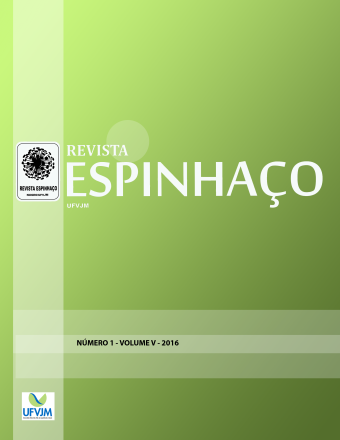Características químicas, mineralógicas e físicas domaterial acumulado em terraços fluviais, originado do fluxo de lama proveniente do rompimento de barragem de rejeitos de mineração de ferro em Bento Rodrigues, Minas Gerais, Brasil
Revista Espinhaço
Características químicas, mineralógicas e físicas domaterial acumulado em terraços fluviais, originado do fluxo de lama proveniente do rompimento de barragem de rejeitos de mineração de ferro em Bento Rodrigues, Minas Gerais, Brasil
Autor Correspondente: A. C. Silva | [email protected]
Palavras-chave: Heavy metals, contamination, recovery of degraded areas, agricultural areas
Resumos Cadastrados
Resumo Português:
O rompimento de uma barragem de rejeitos de mineração de itabirito na cabeceira da Bacia do Rio Doce (Minas Gerais e Espírito Santo, Brasil) provocou a maior catástrofe ambiental do Planeta Terra, relacionada a esta atividade. Os rejeitos foram depositados tanto no fundo como no terraço fluvial dos rios provocando o assoreamento e mudanças profundas na qualidade das águas e soterramento das principais áreas agrícolas desta bacia. Para que elas retornem aos níveis anteriores ao desastre é imprescindível que o material depositado nos terraços fluviais seja minuciosamente caracterizado. O objetivo deste trabalho foi caracterizar química, física e mineralogicamente o material proveniente do rompimento da barragem do Fundão, depositado no terraço fluvial do Rio do Carmo, afluente do Rio Doce. O material foi coletado na profundidade de 0 a 30 cm de uma camada de rejeito de cerca de 3 metros de espessura, depositado no terraço fluvial da margem direita do Rio do Carmo, na área urbana de Barra Longa, em Minas Gerais. Foram realizadas análises físicas (granulometria, densidade do solo e de partículas e porosidade), químicas (pH; complexo sortivo; matéria orgânica; Fe, Mn, Cu, Zn, Pb, Cd e Ni trocáveis; óxidos totais) e mineralógicas (difratometria de raios X e espectrometria Mössbauer). O rejeito apresenta elevados teores de areia e de silte e baixo teor de argila. Suas densidades do solo e de partículas são elevadas e a porosidade é baixa. O pH é alcalino, os teores de matéria orgânica, de nutrientes de plantas e a CTC são muito baixos. Os teores dos metais pesados Zn, Cd, Cu, Pb e Ni trocáveis são muito baixos e os teores de Mn trocável do rejeito é elevado. Os óxidos totais predominantes do rejeito são o SiO2 e o Fe2O3. Os minerais mais abundantes do rejeito são o quartzo e a hematita. Os atributos físicos, químicos e mineralógicos do rejeito da mineração restringem o restabelecimento da vegetação nativa ou o uso agrícola dos terraços fluviais nos quais foi depositado.
Resumo Inglês:
The rupture of an itabirito mining tailings dam at the headwaters of the Doce
River
Basin (Minas Gerais and Espírito
Santo,
Brazil) caused the greatest environmental catastrophe of the planet Earth related to this activity. The tailings were deposit
ed both in the
bottom and on the riverside terrace of the rivers, causing silting and deep changes in the water quality and
burial of the main agricultural
areas of this basin. For these areas to return to pre
-
disaster levels, it is imperative that the material deposited on the river terraces be
thoroughly characterized. The objective of this work was to characterize the mater
ial from the rupture of the Fundão dam, deposited on
the river terrace of the Carmo
R
iver, a tributary of the Doce
River
. The material was collected at a depth of 0 to 30
cm from a tail layer
about 3 meters thick deposited on the river terrace on the right
bank of the Carmo
River
in the urban area of Barra Longa, Minas Gerais.
The physical analyses included soil, particle and porosity density, chemical analyses were pH, sorption complex, organic matt
er,
exchangeable Fe, Mn, Cu, Zn, Pb, Cd and Ni, total oxid
es, and mineralogical analyses were performed by X
-
ray diffractometer and
Mössbauer spectrometry. The reject has high levels of sand and silt and a low clay content. The densities of soil and particl
es are high,
and the porosity is low. The pH is alkaline,
the levels of organic matter, plant nutrients and CEC are very low. The exchangeable heavy
metals Zn, Cd, Cu, Pb and Ni are very low, and the exchangeable Mn contents of the tailings are high. The predominant total o
xides of
the tailings are SiO
2
and Fe
2
O
3
. The most abundant minerals of the tailings are quartz and hematite. The physical, chemical, and
mineralogical attributes of mine tailings restrict the restoration of native vegetation or the agricultural use of the river
terraces on which
it was deposit
ed

